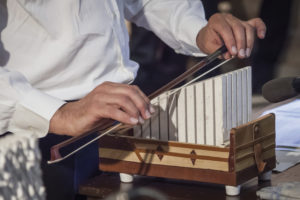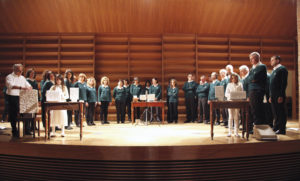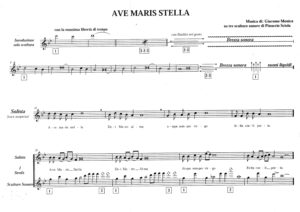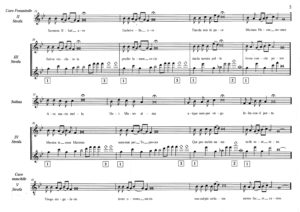Por Giacomo Monica, director coral y profesor
1. La armoniosa belleza de la estética.
Un posible diálogo entre los sonidos de las rocas (la voz de la naturaleza) y la voz humana (en el coro).
A primera vista llama la atención y nos preguntamos de inmediato: ¿por qué se habla de una escultura en una revista especializada de música como es el BCI? En esta revista se debate sobre varios géneros y estilos y las interpretaciones de los mismos, además de prácticas interpretativas, exclusivas propuestas que descubren compositores y composiciones desconocidas (o al menos poco interpretadas, pero relevantes). Además, en esta publicación también se tratan asuntos relacionados con los instrumentos, los coros, la voz y las técnicas de apoyo necesarias.
Si la esencia de todo (en un sentido amplio) es la voz, y la voz es sonido, también se puede investigar sobre el origen del sonido, cómo nació, de qué material viene, las características que presenta, cuáles son las zonas resonantes, cuál es el poder expresivo del sonido, etc.
Gracias a las esculturas sonoras de Pinuccio Sciola, nos podemos adentrar en una dimensión ancestral, mágica pero real al mismo tiempo, en la que entendemos ese concepto fundamental para cualquier músico: el sonido nace del silencio. Y simplemente así, asociando ideas, nuestra mente nos lleva de vuelta al libro de técnica coral de Fosco Corti, Breath is already singing (La respiración también es cantar), o a los escritos de Y. Menuhin, Music and interior life (Música y vida interior).
El sonido ya existía desde la época primordial, antes de estar presente en los hombres (en sus cuerdas vocales), como ya existía en las rocas antes del nacimiento de la luz… (o eso es lo que dice el escultor). Es maravilloso y no resulta utópico pensar que la voz está en todas las cosas, desde los hombres hasta las rocas, y esta es el alma secreta de un misterio. No está atrapada ni ahogada, sino todo lo contrario, se encuentra libre; el sonido nos lleva a dialogar con nosotros mismos, cualquiera que sea nuestra naturaleza.
No resulta inconcebible pensar que los compositores contemporáneos, cuyos innovadores lenguajes dirigidos a experimentar participan constantemente en la evolución de la investigación, pueden encontrar soluciones llenas de significado, no solo a la hora de enfrentarse a las esculturas de Pinuccio Sciola como “mobiliario musical”, sino como una forma relevante de lenguaje primario que se puede explicar de forma directa, y se convierte en una necesidad para el diálogo entre el elemento naturaleza-rocas y el hombre canto-voz-sonido.
Conseguir unificar más las artes entre sí, romper esas barreras mentales que se interponen con facilidad y que evitan el paso de una disciplina a otra, significa dar un pequeño paso hacia adelante a la hora de entender el arte en sí mismo; es decir, es asegurarse de que, en este caso, la polifonía y la litofonía (voz-roca) son complementarias y se compensan la una con la otra, y esta relación se consigue normalmente entre la actuación y el canto.
La voz entre naturaleza y hombre, entre respiración y canto, entre materia y alma, entre técnica y artes es algo que permanece como la esencia de todo.
2. El Significado de la investigación composicional en diálogo con la voz.
Cómo interpretar y tocar las esculturas.
En mi opinión, con las esculturas sonoras de Pinuccio Sciola uno no debería gritar a los cuatro vientos que ha inventado una composición (distintos músicos han tratado de escribir y experimentar sobre este asunto). Son esculturas vivientes para las que se tiene que saber cómo interpretar en el verdadero sentido de la palabra. Cada una de ellas habla un idioma diferente en relación a las propiedades físicas del sonido (afinación, intensidad, timbre) y en relación a la forma, tamaño, peso, espacio, calibre de las cuerdas de piedra, la profundidad o no de los cortes y el tipo de estrés a la que esté sometida.
La composición ya se encuentra en la roca y habla su propio idioma. Todo tiene un código de inicio específico y se puede usar para cuestiones expresivas, y en la matriz ya hay un esqueleto predeterminado que sugiere esas soluciones interpretativas, con la condición de que haya un deseo y una voluntad de escucha profunda, meditando, para así obtener mejor el sonido y proponerlo de nuevo. Siglos de historia nos han otorgado maravillosas esculturas en tres dimensiones que todavía nos encandilan hoy en día. En un pasado cercano, se medía a otros artistas con emocionantes esculturas que creaban cuatro dimensiones; algunos de ellos, con esculturas que producían sonidos mecánicos, entran en la categoría de la experimentación con cinco dimensiones. Pinuccio Sciola fue más allá, creando encandiladoras esculturas de seis dimensiones cuyas rocas cantan.
En el estudio de la composición es normal no crear barreras entre las vibraciones de las rocas y las vibraciones de las cuerdas vocales; por lo tanto, la investigación se centra en este concepto de intercambio y compensación. El sonido en la voz humana cuando “se congela” puede contrarrestarse con estos sonidos que se liberan de la roca, en un continuo vaivén entre la palabra cantada y el sonido. La voz de la naturaleza, en una correspondencia precisa con la voz humana, crea una especie de simbiosis primordial que puede despertarse y animarse.
Una vez que las manos del artista han esculpido la obra, bien en caliza o basalto, el músico tiene la delicada tarea de interpretar lo que surge, haciendo que las esculturas puedan comunicarse entre ellas o puedan unirse a la voz humana. Proponer la belleza de este nuevo recurso expresivo representa para mí una fuerza de profundo interés comunicativo. No solo por simple y superficial curiosidad, sorpresa o por un efecto dramático peor, sino más bien por adentrarse en el pulso de una nueva dimensión que añade el valor y esencia de un lenguaje que, además de formal y estético, por encima de todo está vivo y es brutal, etéreo y vibrante.
3. Dos ejemplos composicionales
Sound Profile (con texto de Yehudi Menuhin)
Concatenación de sonidos en su color místico
Duración aprox.4 minutos
De las esculturas de caliza emergen líneas monódicas en sucesión, tan cortas como las secuencias Gregorianas, cuya tonalidad es un resultado aleatorio, producto del corte del material elegido por el escultor, según la forma, la estética, la profundidad y el grosor, y de cómo se conforma la materia teniendo en cuenta sus células menos comprimidas y sedimentadas. El alma sónica de la materia, con su potencia, limitaciones y singularidad (cada escultura tiene una especie de código genético, con notas musicales, único y no modificable), se autoimpone al músico que busca un camino creativo. Los pliegos de las litocuerdas emiten tonos, colores sonoros y atmósferas al límite de la escucha, los cuales pueden flotar en silencio y hablarnos.
Es desde el silencio de donde se genera el sonido. La estructura de la pieza consiste en cuatro periodos cortos (interpretados con un arco en una escultura y acompañados por sonidos complementarios de reflexión que se obtienen de otras esculturas), todos ellos precedidos por una breve lectura sobre el valor del silencio, resultado de la reflexión de Yehudi Menuhin, un gran violinista, intérprete y profesor.
“El valor del silencio” (extracto de Music and Inner Life)
Yehudi Menuhin
Silencio. Pedir a un músico que hable de algo que, aparentemente, es lo contrario a lo que representa, puede parecer estúpido, o al menos paradójico. Pero dejad que explique lo que significa para mí, como músico, el silencio.
Esta iglesia tan hermosa nos da un ejemplo de paz y nos permite explorar cuidadosamente el profundo significado de esta palabra. ¿Acaso no es el silencio “la verdadera esencia de lo que esperamos, de todo aquello que no hemos conseguido”? En este mundo extremamente superpoblado el silencio se ha vuelto ausente e intentamos llenar el vacío con palabras sin sentido, más que con algo real, con algo más profundo; con fe, por ejemplo. ¿Y qué es lo que queda vacío más que una dulce y pequeña voz que ya no percibimos entre el terrible ruido que llena nuestras vidas?
El silencio es la calma, no el vacío, es la claridad, pero no la ausencia de color; un corazón sano expresa un ritmo así; es la base de todo pensamiento, de la verdadera creatividad. Del silencio viene todo lo que vive y permanece; aquel que mantiene el silencio dentro puede parecer impasible desde el ruido exterior, porque el silencio nos conecta al universo, al infinito. Es la raíz de la existencia y da equilibrio a la vida. El silencio es tangible e intangible al mismo tiempo, y es con este sentido cuando me atrevo a llamarlo música.
Ave Maris Stella
Composición en la que la voz humana interactúa con los sonidos de la naturaleza.
Esculturas, voz y coro.
Duración aprox. 5 minutos
Las esculturas sonoras interactúan con la voz humana y se interponen en momentos en los que se crea un contrapunto arcaico para dos voces. Naturaleza-hombre, materia-espíritu, silencio-sonido, en una unión entre lo tangible y lo abstracto. El texto religioso sobre la pureza de María, Estrella de los Mares, lo acompaña e interpreta todos esos sonidos en los que la calcita, nacida del agua, vuelve a su estado líquido para ser un eco y cantar al compás de la naturaleza.
4. Aspectos de la enseñanza y el aprendizaje
Descubrir y sentir la materia con distintos ojos
Cuando un niño descubre que el sonido se encuentra dentro de todos los elementos de la naturaleza, y por tanto también en las rocas (que por definición se clasifican dentro de los elementos fríos, estáticos, inertes y sin vida), siente una inmensa alegría que nos deja completamente asombrados; permanece en silencio frente a la roca que habla en su lugar, canta y cuenta, que quiere hablar con él.
- ¿Cuál es la importancia de que un niño entienda que el sonido viene del silencio?
- ¿Y que no es fácil escuchar el silencio?
Pero las piedras también sugieren esto.
Cada niño con sus propias manos, afinando su tacto, pueden acariciar, frotar, golpear y jugar con las esculturas de Pinuccio Sciola e inmediatamente empatizar con ellas; jugar con piedras puede encontrar muchas respuestas a su sensibilidad y curiosidad, una curiosidad de gran importancia al ser el núcleo del crecimiento intelectual.
Cuando un niño descubre la estética y la belleza armoniosa, refinada y delicada, se acerca al arte; concretamente a descubrir las características intrínsecas de este y a darse cuenta de que las artes están conectadas las unas con las otras. La danza, por ejemplo, está ligada al sonido y al movimiento, del mismo modo que están unidas al movimiento las esculturas de hojas de luz suspendidas de Calder, o las esculturas de Tinguely o Munary, que se centran específicamente en el sonido que causa el movimiento. El camino sigue más allá, a una mayor aproximación cronológica, y es cuando llegamos a las esculturas de Bertoia que al tocarse desencadenan una bomba de sonidos ensordecedores.
Gracias a las esculturas sonoras de Sciola, el niño se da cuenta de que este no es un objeto común, sino que es algo vivo que le pertenece y contiene un alma sonora que se guarda en el interior de la roca.
Jugar con una escultura es también una maravillosa oportunidad de acercarse al maravilloso mundo de la música. El niño comienza a aprender, a ver y escuchar la materia de forma diferente, con un oído más atento y una mente preparada para un aprendizaje activo pero divertido, mucho más viendo que la escultura se puede convertir en un juego.
5. Enlaces y vídeos
Sound Profiles: http://bit.ly/1QW1LX3
Ave Maris Stella: http://bit.ly/1M0wEN0
Giacomo Monica estudió música en el Conservatorio de Música de Parma, obteniendo el premio extraordinario en la especialidad de violín; posteriormente estudio en la Accademia Chigiana, en Siena, junto a Salvatore Accardo. Actualmente es profesor de violín en el Conservatorio “Boito” en Parma. Desde los años 70 también se dedica a la música coral y a la investigación en etnomusicología, participando como ponente en conferencias nacionales sobre música folk, además de ser jurado en muchos concursos internacionales. Asiste sistemáticamente a cursos para jóvenes cantantes y directores corales. En 1978 fundó el Coro Montecastello de voces mixtas, para el que compuso las piezas que forman el repertorio y con el que realiza actividades corales regulares. En 2008 recibió el prestigioso Premio Caravaggio por la atención y la apreciación hacia la canción folk a través de la investigación en etnomusicología y los arreglos corales. Recientemente se ha interesado bastante por las sonoridades que guardan las esculturas de Pinuccio Sciola y ha estudiado, de forma rigurosa, nuevos caminos expresivos en diálogo con la voz. Correo electrónico: giacomomonica.3@gmail.com
Traducido del inglés por María Ruiz Conejo, España
Revisado por el equipo de traductores de español del BCI








